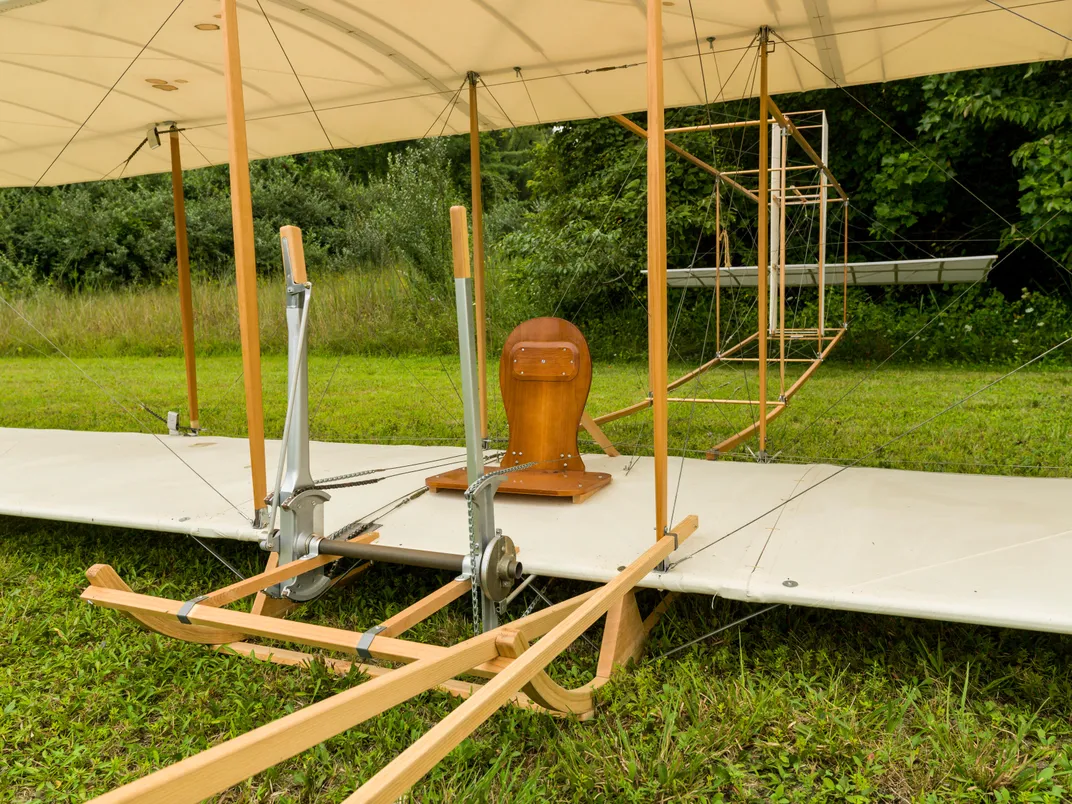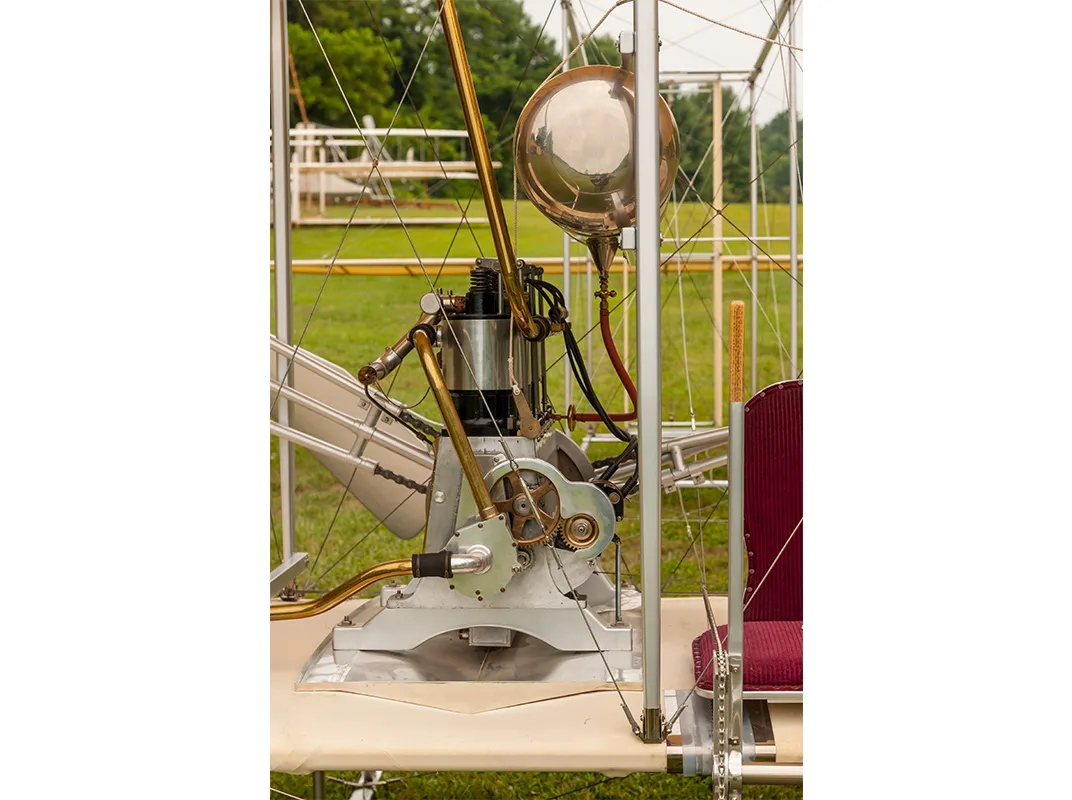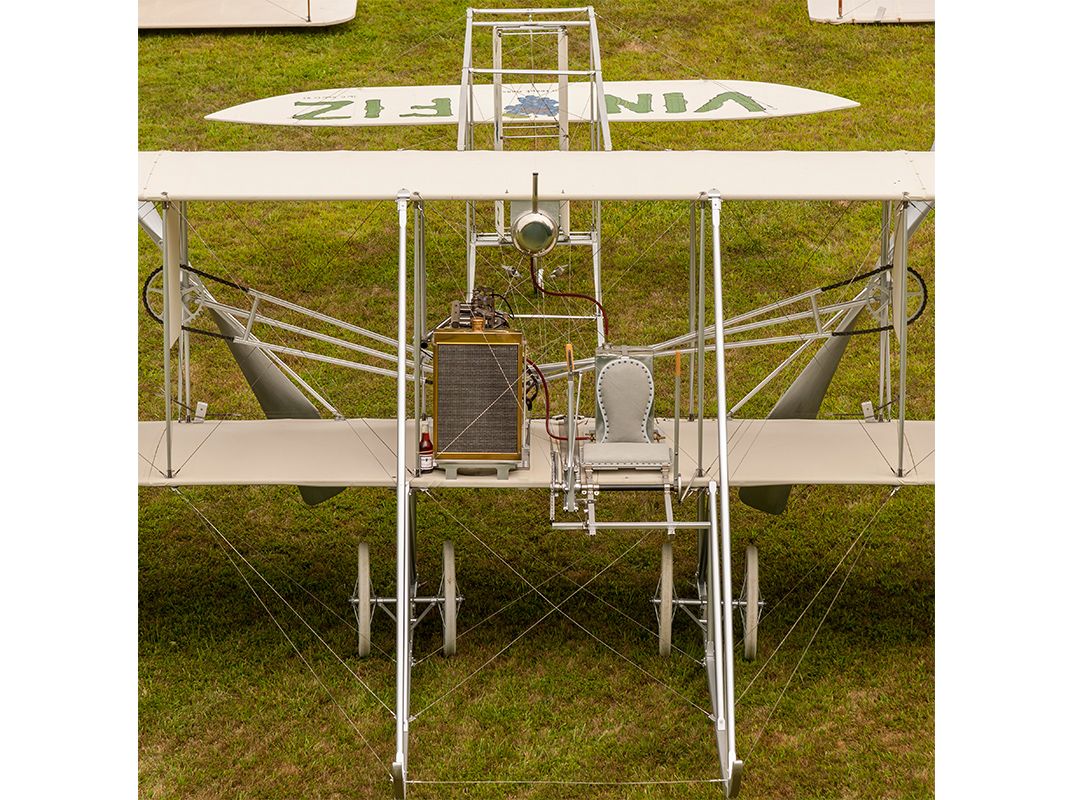Airplanes Seeking Good Home
A one-of-a-kind collection of scratch-built Wright aircraft is up for sale.
/https://tf-cmsv2-smithsonianmag-media.s3.amazonaws.com/filer/19/ff/19ffa76c-cb26-4dd0-87f4-fd64d7f2e9d4/02d_on2015_wrightpan3_live.jpg)
There are only two guys who have built more Wright brothers’ airplanes than Ken Hyde and his Wright Experience team: Orville and Wilbur. Hyde’s count so far is 21. They include all the gliders built between 1900 and 1911, three 1903 Flyers, the long-lost 1908 Fort Myer Flyer, and four 1911 Model Bs (one with an original Wright engine).
While most of the airplanes Hyde has built belong to museums around the country, seven of them still reside in his shop in Warrenton, Virginia. He’s hoping to find a museum to buy the airplanes and a second original engine (serial number 59), built in 1911 by Wright mechanic Charles Taylor himself.
“We’ve only done the first part of this—re-creating the airplanes,” Hyde says. “It needs to go to the next phase, which is to keep the collection intact and housed some place where the public could enjoy it.”
Hyde believes young people can get excited about aviation by learning the Wrights’ story—two brothers building bicycles and playing with kites who go to the beach and invent one of the most transformative objects of the 20th century. He hopes re-creating their work will inspire future generations of aeronautical innovators. “[The Wrights] show a great practical application of mathematics,” he says. “They’re persistent. They’re brave.” And, he adds, they were so industrious and achieved so much, it’s hard to figure out when they slept.
Hyde and his team know something about this. They’ve been learning intently, sometimes sleeplessly, about the Wrights’ engineering for more than 25 years. Beginning in 2000, when I built a website for the group and worked with them to develop education projects, I’ve watched the activities in Hyde’s shop, nestled in the Virginia countryside. As soon as I walked in, I could tell that it was different from other restoration shops I’d seen. It’s a real Wright airplane factory, where almost everything is done in-house—from scratch-built Wright engines to hand-carved propellers. “We usually find it’s best to make it ourselves,” Hyde says. “That’s what the Wrights did.” And it’s packed with projects squeezed in and around the maze of Wright machines. Here is a Jenny; over there a 1929 Parks PA-2 (a three-place biplane used in airmail service and flight training at Parks Air College). There’s Wright engine no. 59.
Hyde and his team, sponsored by the Ford Motor Company, built the 1903 Flyer used in the December 2003 centennial of flight reenactment in Kitty Hawk, North Carolina. Weather and a misfiring engine prevented a successful flight on the big day, but the Flyer had flown before the December 17 ceremony. The team had succeeded in creating a Flyer that flew just as the original had flown for the Wrights: when conditions were right.
For most, the 2003 celebration was the culmination of interest in the Wright brothers, but Hyde had begun an investigation he felt compelled to continue. “There was no way to stop after 2003,” he says today. “There were still so many questions. Orville and Wilbur couldn’t wait to get to their shop every day. And that’s what happened with us—it takes all of us to get our heads together to figure out what they did. We’ve still got a lot to learn.”
Hyde’s team has varied over the years, but there are several core craftsmen: Greg Cone, the Charlie Taylor of the group and Hyde’s longest-standing employee, has several Wright engines to his name; Cliff Guttridge handles the metalwork; Bill Hadden creates the drawings and does piecework in almost every phase of construction; and Scott Rawlings manages the woodshop and keeps the projects in line.
It all started in 1992, when the Army Aviation Museum in Fort Rucker, Alabama, commissioned Hyde, already renowned for restoring antique aircraft, to make a static Wright Model B for display. He figured he could simply get some plans from a museum and get to work, but he quickly discovered there were no plans. He began to look for clues. “It was six months before we cut the first piece of wood,” he says. He realized that the Wrights’ engineering had never been completely understood.
Most of the knowledge about their airplanes existed only in the Wrights’ heads. They made drawings, but only fragments remain. How did they design and build their aircraft? How do they actually fly? Hyde and his team have spent thousands of hours in research: finding, copying, and scrutinizing every photo, letter, diary entry, newspaper article, film, and object they can find; making 3D scans of prop fragments; running dynamometer tests of original engines; developing a technique for creating AutoCAD models of the airplanes and matching them to photographs. (With this technique, if they have one reliable measurement for a component, they can get accurate measurements for the rest of the airplane.) The 1908 Fort Myer Flyer, which was destroyed in a crash, was rebuilt thanks to detailed photographs Carl Claudy took during the Army trials. “It’s as if he knew we’d need them 100 years later,” says Hyde.
They have re-created the famed Pride of the West muslin (based on fabric samples provided by the Wright family); they sent a sample of the original aluminum powder finish to a lab to be analyzed so they could get the exact grain size for the reproductions. They are fanatical craftsmen, from the superficial—getting the nickel-plated metal components to make the Model B shine “like a fine piano”—to the critical, such as making sure the hand-carved propellers balance perfectly.
Today, the core of Hyde’s collection is a group of seven airworthy aircraft, representing about 60 percent of the Wrights’ experimental and commercial work. Like all Hyde reproductions, each is an exact duplicate of the original. The collection includes a 1902 glider, configured as Orville and Wilbur flew it in 1903; and two 1909 Military Flyers, one already outfitted for flight-testing, with places set up to record engine and propeller data, and the other configured as Wilbur had it at College Park, Maryland, in 1909. The engines on these 1909 machines are exact duplicates of the 1908 “US” engine, which is installed on the original 1909 Flyer at the National Air and Space Museum. (In 2007, Hyde’s team was allowed to build a scaffold under the Flyer so they could access the engine interior; the engine hadn’t been opened since 1911.)
Also for sale, the sole example of a 1910 “transitional” Flyer, which has both a forward canard and a rear elevator. Hyde’s team configured it as Orville had at the Wrights’ first training facility, in Montgomery, Alabama. Three more aircraft round out the collection: a 1911 Model B, which has flown and is ready to fly again, with an original engine (serial number 33); a 1911 glider, replicating the machine in which Orville set the first soaring record, in an October flight lasting 9 minutes, 45 seconds; and a 1911 Model EX, which is meticulously painted to duplicate the paint on Cal Rodgers’ Model EX Vin Fiz. National Air and Space Museum chief curator Peter Jakab made it possible for Hyde’s team to take a digital sample of the colors of the fabric on the original Vin Fiz, which hangs in the Museum.
Because there have frequently been no drawings or written steps to follow, Hyde and the team have duplicated not only the machines the brothers built but their likely method of engineering and experimentation. At one point, for example, the builders needed to replicate the 1911 Model B’s chain guides—the metal tubes that keep the chains driving the propellers on track. The tubes are oval in cross-section, and getting a manufacturer to produce them was prohibitively expensive. “So you go to bed wondering what to do, wondering what the Wrights did,” says Hyde, “and you wake up in the middle of the night with the answer. You get a one-inch piece of tubing, put a 3/4-inch piece of bar stock in it, crank it in the vise, and it comes out perfect.”
All of the aircraft in the collection are airworthy because that’s how the brothers learned—through flight tests. “We need to do flight tests, get the data off the airplanes,” says Hyde. The data would allow the brothers to build accurate simulators. Hyde also feels that demonstration flights (of the airplanes that are easier to fly) are important for public education about the Wright brothers and the progress they made from one model to the next.
Hyde insists on accurate re-creations because he is trying to retrace the steps the brothers took in learning about flight. “If you change things, any data that comes from testing reflects what we know now. So when we test an accurate airplane, we learn what they knew,” he says. The team learns what Hyde calls the brothers’ “secrets.”
What’s the biggest secret? “It’s hard to say—there’s a lot of small steps that improved the airplanes as they moved forward,” Hyde says.
“They knew how to beat mean old Mr. Gravity,” Greg Cone says. Cone restored engine #20, built about 1910 in the Dayton factory. There are all sorts of things to reduce weight—aluminum crankcase, simple fuel injection, tubular connecting rods, suction-operated intake valves, and strange little slots cut into the bottom of each cylinder. “[The slots] are auxiliary exhaust ports,” says Hyde. Working with Delphi Labs and the University of Rochester, he ran a full set of dynamometer tests on the engine. The tests showed the exhaust slots helped lower the cylinder heads’ temperature. “Too much heat leads to things like valve failures and detonation problems,” he says.
So the engine was simple in order to be reliable, and provided modest power. It didn’t need to do more. Hyde’s wind tunnel tests show the Wrights’ 1911 “bent end” propellers—the kind driven by engine #20—have a peak efficiency of 81.5 percent. (Propellers today are about 84-85 percent efficient.) “That’s how they can get so much airplane into the air with just 35 horsepower,” he says.
Other discoveries have been inferred from existing evidence: Flight test data from 2003 shows the 1903 Flyer was most likely overpowered. The wooden dowels attached to the canard booms of the 1910 transitional Flyer were likely visual aids, showing Orville’s students where to place the trailing edge of the canard in a climb. The engine’s compression release system enabled the engine to be primed, but also served as the kill switch (rigged so if you fell forward in a hard landing, you’d trip a string and shut off the engine). There are countless other revelations in store.
Hyde stresses he’s far from finished, and wants to see the collection grow. He has not yet re-created the 1904 Flyer II and the 1905 Flyer III. “They should be in the collection,” he says. “I think the ’04 is the most important of all, because that’s one of the only times they were doing trial-and-error, trying to get the airplane to fly better.”
Hyde imagines a place where it’s all brought together: a facility with a grass strip where airplanes can be taken out and flown, where there’s easy access for the public, where the data can be preserved and studied, and where young people can get their hands on real Wright machines. Brand-new ones. And with the knowledge passed on, there can be more on the way—airplanes and innovators both.


